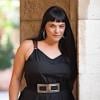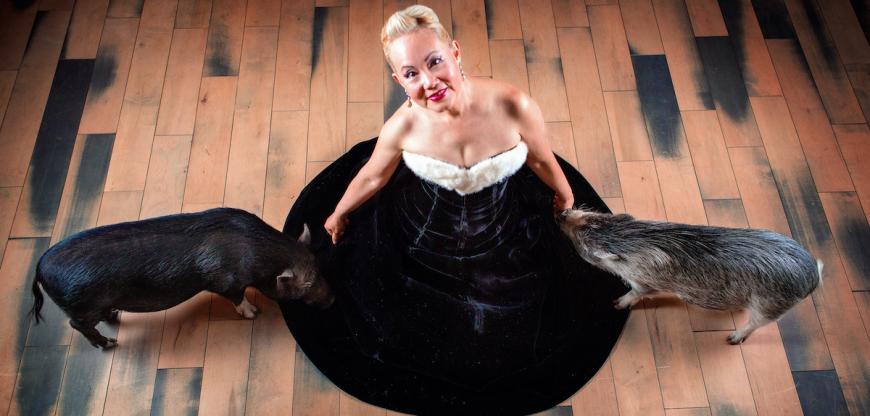
White Snake Projects Executive Director Cerise Lim Jacobs is the librettist and creator of “activist” operas including the Ouroboros Trilogy. The second installment of the trilogy won the 2011 Pulitzer Prize for composer Zhou Long’s Madame White Snake. During the pandemic and stripped of live performances, Jacobs’s rapid output of an opera a year might have seemed destined to stop or at least pause. After founding the company in 2005 with her late husband Charles Jacobs — her grief upon his death in 2015 caused her to stop working for three years — Jacobs in 2020 thrust herself into an entirely new gear and abruptly reconfigured White Snake into online productions.
Jacobs immersed herself in presenting virtual reality operas, launching community-based initiatives, and developing a new game platform and synchronous audio technologies and plugins. She was again exposing herself to the toss-and-turn vortex of being a novice, just as she had years earlier by bravely embarking on a career in contemporary opera after two decades as an attorney.
In a phone interview, she talked about the vulnerability and strength that characterize her mission to tell stories and histories about overlooked groups and cultures — including immigrants, among whom she counts herself (Jacobs was born in Singapore). Stories, she says, need to be lifted into awareness to address not only immigration and relocations but the struggles and victories of all sorts of people, from those in long-term incarceration and their families to survivors of racist or xenophobic violence.
Reviews by opera’s traditional “gatekeepers” are not always favorable, and Jacobs admits to self-doubt and fear each time she mounts a new production. Even so, a promise she made to her husband and an inner thread of strength like a steel cable holds her upright as she tilts into the winds of opposition, eager for the next time she will be a novice on the way to expressing a newfound truth.
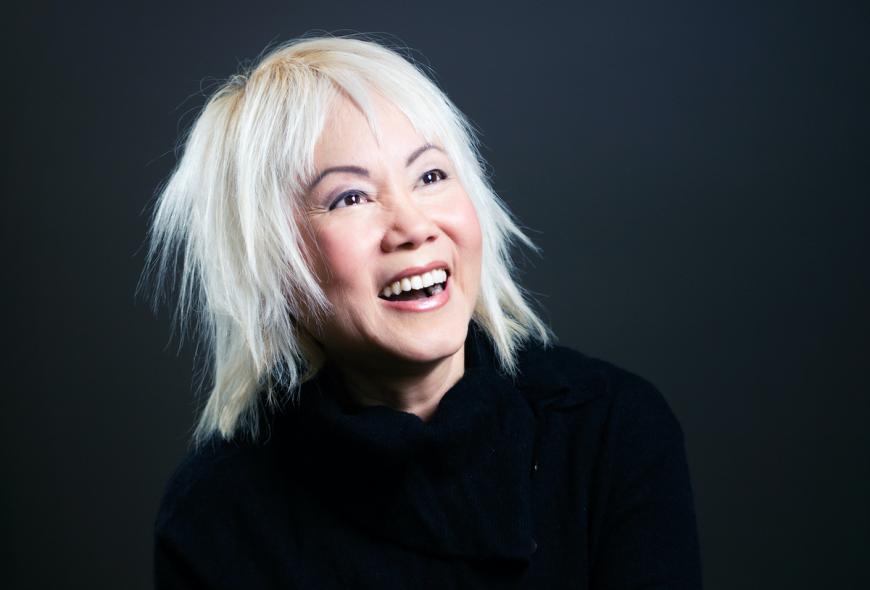
Tell me about the response to the Sing Out Strong program, one or two future projects under this umbrella, and if it will stay online or be a hybrid when COVID-19 is less in the picture?
Sing Out Strong was conceived as a way of equalizing the disparity between professional writers and artists with everyday people. People tell me they are not artists, but we believe everybody is creative. That creativity just has to be released. Also, SOS was formed to elevate community projects to the level of real artistry. With community projects or engagement in other companies and other organizations, you will find a deep, solid, high wall between the artistic and the educational projects. That’s frankly bullshit.
The response we have had is overwhelmingly positive. People have written about the authenticity of the voices. They are amazed that regular people could be included. We will continue the series with a project in the pipeline. We plan it to be online because of the amazing reach that online has with communities that couldn’t come when it was all live concerts. We’ll also plan to do in-person neighborhood concerts next year.
Please talk about the tech you use in your productions: the game engine Unreal that creates immersive 3D sets and avatars and the audio plugin that enables live synchronous performance from remote locations. What effort was involved?
The effort was enormous because we were pioneering in every step of the process. It started on the audio side. I was completely ignorant about the constraints on virtual performance, and so I commissioned an audio engineer to solve the latency problems. I was not interested in making a prerecorded video. I got a call one evening saying, “Cerise, are you ready?” I said I’m always ready, and it was my audio engineer and a couple of other people and they performed “Billie Jean” live, synchronously, from remote locations. We knew we had the beginning to a solution.
How do the capabilities you’ve developed and mastered expand the field of opera?
We premiered Alice in the Pandemic during the pandemic to do a proof of concept. It proved it. There was interest in the music industry, and we decided to create an actual audio plugin. The process is extremely labor-intensive. It would not be practical for most musicians to use [what we were using]. We had a software engineer develop a prototype. We tested this audio plugin and named it Tutti Remote. It was beyond successful: the synch was rock solid. That happened just this May. Now we are developing more capabilities to make it a tool for uses ranging to professional audio for a professional musician or studio to an at-home musician who just wants to perform with other musicians. We are developing a subtitle capacity and other functionalities to enable a small company to fully produce an opera.
The stories you select have themes with contemporary social relevance or involve college students as collaborators. Might these other assets, in addition to newfound technology, attract young people or nontraditional audiences to opera?
My collaborations are not just with colleges and students, my collaborations are with community advocacy groups. It’s through them I enlarge the traditional opera audience. Once a community is involved, we continue to involve them — we offer their constituency free tickets, promote their causes and work. That is one way I hope to grow the audience from the norm, the usual white, upper to middle class, older people, to a more diverse group. An audience who’ve never seen an opera in their lives and are amazed we can tell a story in an opera they can relate to.
We got a lot of young people with Alice because of technology. It appealed to gamers who would never go to an opera. But when they saw on Facebook the animations and kinds of worlds we created through the game engine, there was a lot of conversation, I saw things that said, “Wow, that was amazing. I’ve never been to an opera before!” With us, price is never an obstacle to attending one of our shows, so there’s no risk. Just come as my guest and check it out.
What can you tell me about these operas upcoming in 2022 and 2023, including the colonization opera Cosmic Cowboy?
In September of 2021, we premiere the third opera in the pandemic trilogy. It’s called Survivor’s Odyssey. Cosmic Cowboy was supposed to premiere in the fall of 2020. That is an opera that is entirely sci-fi, political science fiction. It explores the instinct of wanting to colonize other people. Colonization, that instinct is one of the reasons we have this state of conflict in the world. Almost every country in the world controls boundaries that have caused conflicts. It has also resulted in the mass migrations we are experiencing now. We are also looking at the fantasy story of a space probe that has landed on a comet. We’re using that to explore this virtual world using virtual reality, real-time facial motion capture. Part of that is our desire to attract audiences using cutting-edge technology that is unfamiliar and that they will find very entertaining. Outer space is a reality, but since we haven’t been there, it’s boundless. We can imagine anything.
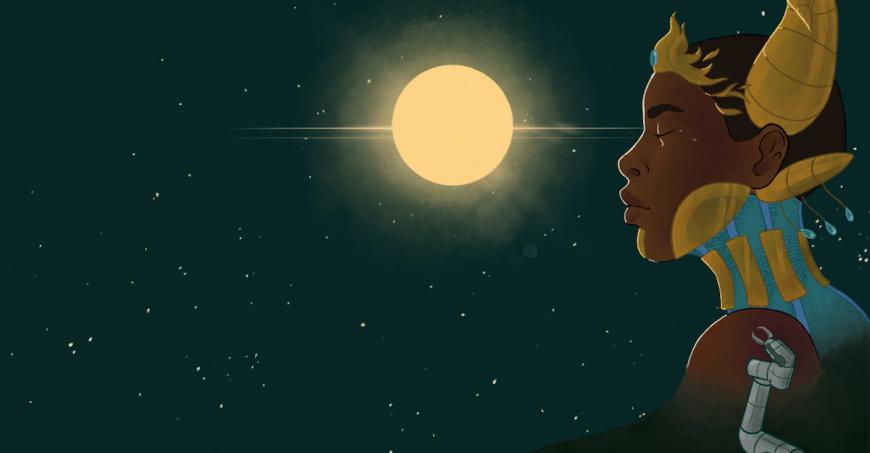
And Monkey: A Kung Fu Puppet Parable?
That is a multicultural opera based on the iconic Chinese quest saga that is the basis for all video games, Journey to the West. Every Asian person knows the story of Monkey. It would have been easy for me to commission a Chinese American composer, but I didn’t. I commissioned a Mexican American composer for the precise reason that I’m interested in how someone with Jorge Sosa’s background would approach an ancient Chinese fable. What sounds would he bring?
As an immigrant from Singapore, do you believe you bring to your librettos an alternative awareness, sensitivity, or dimension about the United States when it comes to your storytelling?
Yes. I totally believe that part of my identity is my immigrant reality. It’s only partially racial. I’m a person of color, but I’m further foreign/other by being an immigrant, by not having a network, by always searching for identity. That is why Madame White Snake was my first attempt at opera. I believe all immigrants are trying to make a new identity. We reach back into our childhood roots to ground ourselves in emotional stability. Once we’ve found it, we can branch out and, in the process, create something new and different. What makes my work different is that I’m writing from the perspective of “other.” Immigrants are always the in-between people. We don’t belong here, but we can’t go back. We’re not acculturated here. Immigrants coming here who are not children, who know the old country and its origins and had political and cultural identities, they’re having to remake themselves in a new way.
What response did you receive to the White Snake project asking people to participate in a think tank addressing racism and calling for increased social justice?
It was unbelievable. I put out the call publicly and reached out to activists, some I knew and some I’d only heard of. We had 20–30 people come to meetings. We tried to bring a response through opera based on the murder of George Floyd and used devices like everybody blindly putting in a phrase, collecting them all, then seeing if they told a story. We came up with the opera that is Death by Life. That is what ultimately resulted.
The artwork in the virtual gallery Art and Imagination Inside Prisons is powerful. Are there any plans to incorporate any of the artwork directly in a future production or employ incarcerated artists in an opera project?
That for now is a virtual gallery, although we do have plans to bring that gallery to the pre-shows of Death by Life. We included [it] in virtual presentations [of Death by Life] to show everybody who came to that opera that gallery. We plan to bring it into the prison systems. It’s a very slow process. Prisons are state institutions with different rules, so we have to go state by state. The first state who saw the opera and the gallery collection, we had a connection into the prison system, and she helped us bring it into Pennsylvania. The next stop is Illinois, and we have another opportunity in Michigan. We saw the impact immediately. So we’re also having a survivor gallery as a way for families and people [impacted by incarceration] to direct and transcend that trauma. We’re curating that gallery now.
What has surprised you about yourself as you have continued this work you began in 2005 with your late husband, Charles Jacobs.
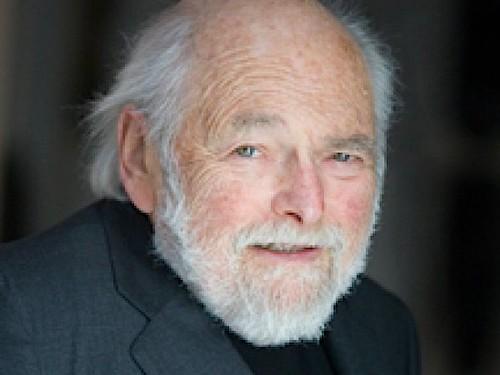
When Charles died, I essentially could not work anymore. Doing work like this, creating new revolutionary operas, there are so many obstacles. Gatekeepers who are the establishment look on this work as marginal, fringe, not worthy of recognition. As a single individual, I did not feel I had the emotional resources to withstand those kinds of rejections. It was impossible for any one person to climb that hill by themselves. I gave up for three years. I didn’t work at all.
It was time that healed the wounds or whatever, but I honestly believe Charles was saying to me I could do this and I could not use him as a crutch. As an Asian woman who grew up in a culture where women were more lowly than dogs, it has been a personal journey. It surprised me that after three years, I could emerge and take steps toward starting. I decided I could finish what Charles and I had started, the Ouroboros Trilogy. I discovered I could actually do this. Yes, I cried, I was terrified like I’d never been scared before. It amazed me that I got it done. I didn’t do it by myself but with other people. What I promised to Charles, that I would finish it, became just the beginning of the journey of White Snake Projects. That was the first step toward a company that would be totally different because Charles was a civil rights advocate and taught me that the mission of uplifting others was more important than uplifting oneself.
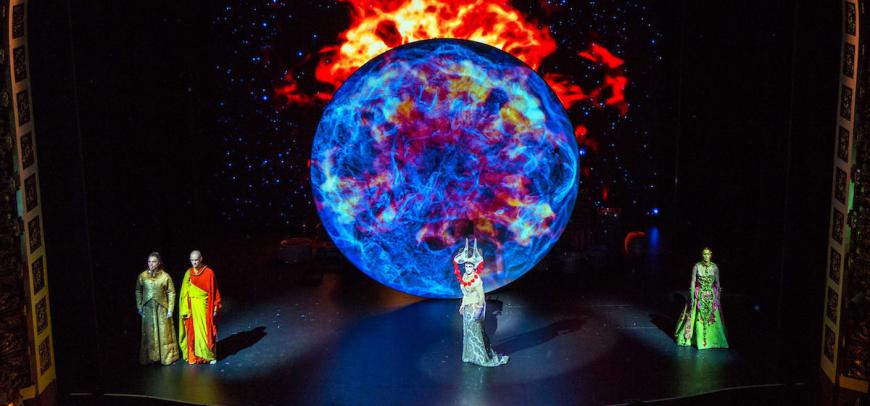
Some artists who are women and people of color tell me they believe race and gender identifiers are restrictive and should be eliminated. Others say they are integral to their identity and are proud of the labels. Where do you position yourself on that spectrum?
I’m definitely a person who yearns for the day when it doesn’t matter. I will then say I’m a creator, but right now, we’re not there. If I were not a woman, an immigrant, if I were a male, I do not think White Snake Projects would exist. There is a need for companies like this to uplift people who are marginalized as long they will exist. If I were a white man born and bred here, I would not have created this company. But because I couldn’t get a seat at the table, I had to create my own table and invite other people who could never get a seat at their table to my table.
What primary skills did you enter with when you began and what skills did you have to acquire or increase in order to bring White Snake to what it is today? You were an attorney for decades before you delved into opera producing.
The assets were that I understood what it took to build a company up from the business end. It doesn’t matter what artistic vision you have if you can’t execute in terms of organization. If you can’t build that, your vision never has a chance to shine. I also had a network of affluent partners, friends to tap into, who knew me as an attorney and knew I was a skilled, competent person and could transfer those skills to build an infrastructure.
The deficit I had was insecurity, in terms of not fully embracing my artistic vision. I thought everybody else knows so much more, is a musician, has been in the business for 40 years and I’m new to it. It gave an excuse for critics and people in the industry to say I was a dilettante and had not paid my dues. Even when she executes well and her first show won the Pulitzer Prize, it was a fluke. My feelings of being marginalized increased. But it made me more determined to outstay my critics. It was not about them, it was about my mission.
If you were to draw a computer graphic describing the arc of your journey, what shape would it take?
In the beginning, I would have a very vertical line. The learning curve was so high. It would then go up and down because psychically and emotionally I was learning I could do this. Now, five years out from the start, it’s still uphill but the curve is no longer vertical, it is more like 75 degrees, uphill line, but no longer as steep. It will always be uphill — until we can stop defining ourselves by race, gender, immigrant status. I don’t feel I’ve arrived yet. Every new work I do is iterating on the last thing; I will never say I’ve mastered opera. That’s why it’s uphill. I could stop trying to reinvent or make it better, or hone and refine and strive, but I want to continue to push myself. That’s where the stress is. I can never sit down and say I’ve arrived. Some days I ask myself if this is what I want to spend my last days doing. That’s why I was afraid to continue without Charles from whom I had personal, intimate support. Now, I have to reach into myself and my team for that strengt



